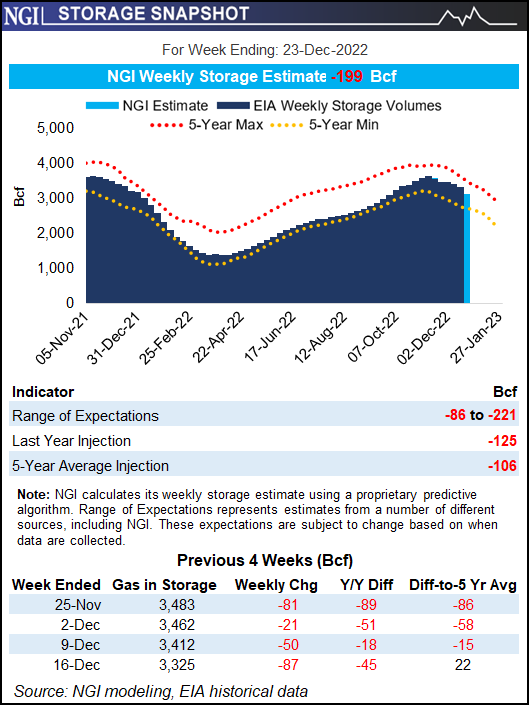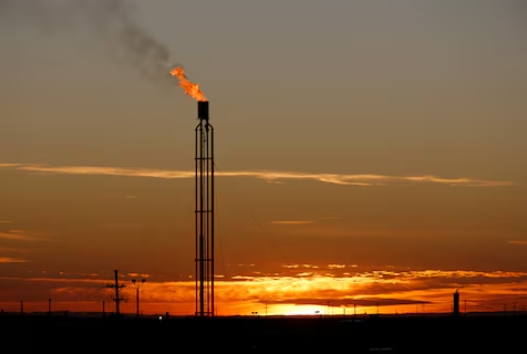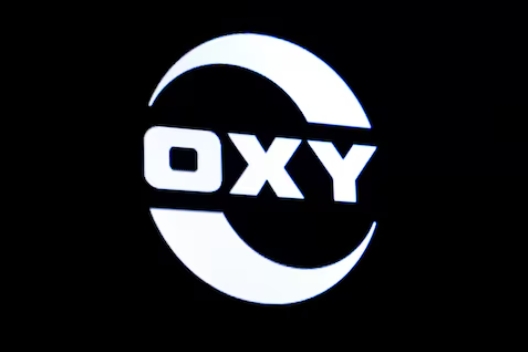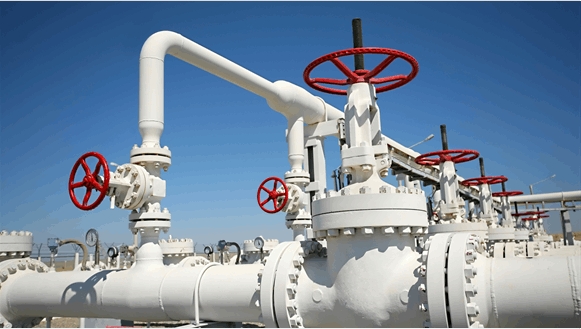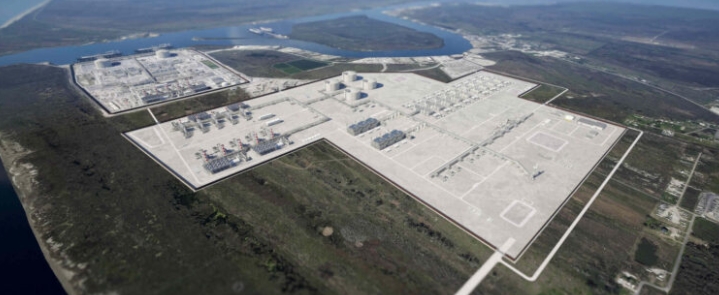With natural gas traders’ fingers and toes still thawing out from the weekend’s Arctic blast, most remained on the sidelines of the action on Tuesday. However, with the potential for cold to return before mid-January and U.S. production sharply lower following widespread freeze-offs, the January Nymex gas futures contract eked out a 20.3-cent gain to settle at $5.282/MMBtu. The February contract climbed 13.8 cents to $5.118.
The impacts of Winter Storm Elliott notwithstanding, trading action was largely subdued after the long holiday weekend. The January contract opened Tuesday’s session at $5.283 but tumbled to a $5.081 intraday low as weather models showed record-setting warmth spreading across the country during the next 12 days. This should bring the lightest demand in more than 40 years, according to NatGasWeather.
The forecaster said unseasonably strong high pressure is set to expand across the southern and eastern halves of the country as the week progresses. Subfreezing air is forecast to retreat into Canada, paving the way for highs to reach the 60s to lower 80s over most of the southern states through Jan. 8. Over the Great Lakes and eastern United States, highs could hit the 40s to 60s, according to NatGasWeather.
The exception would be the West Coast, where the weather pattern is expected to be near normal as Pacific storm systems bring rain, snow and overnight lows in the teens to 40s, NatGasWeather said.
The latest weather data hinted that the span of milder weather could come to an end by Jan. 9, with cold air over Canada seen plunging once again into the northern United States. Of course, it is possible the forecast sees large changes between now and then, potentially to the warmer side, according to NatGasWeather.
“It’s important the Jan. 8-11 period doesn’t trend warmer, or it could lead to further disappointment,” the firm said.
Production also remains a wildcard. In addition to the impact Elliott had on temperatures and demand, the monstrous winter storm also did a number on supply. Tuesday’s early production data pointed to around 80-86 Bcf/d of output. Though temperatures should continue to climb throughout the week, it’s too early to tell when production may return to the 100-plus Bcf/d levels seen earlier this month.
A slew of pipelines continued to report issues on Tuesday, which may limit production’s ability to ramp higher. These included the Algonquin Gas Transmission, Cameron Interstate, Columbia Gas Transmission, Elba Express Co., Northern Border, Rockies Express, Southern Natural Gas Co., Tennessee Gas and Texas Eastern Transmission systems. Florida Gas Transmission also resumed and extended a planned maintenance event that was paused during the cold snap.
With comparisons to Winter Storm Uri’s extreme production losses, EBW Analytics Group LLC said the curtailments could reshape the perception of natural gas deliverability. Instead of a one-in-30-year storm, the natural gas market is weathering extreme freeze-offs of 15-plus Bcf/d twice within three winters, the firm pointed out. Including Uri, production freeze-offs of 8 Bcf/d or more have occurred in three consecutive winter seasons.
“The towering production growth of the past decade, particularly from liquids-driven associated gas production, leaves the market more susceptible to freeze-offs,” EBW senior energy analyst Eli Rubin explained. “Many producers, meanwhile, were badly burned during Winter Storm Uri by pre-selling production that ultimately could not be delivered. Although it is unclear if similar consequences occurred during the most recent cold snap, producer winter hedging strategies may shift.”
Grid (In)Stability In Southeast
Not surprisingly, all eyes were on Texas – and specifically, the Electric Reliability Council of Texas (ERCOT) – as Elliott rolled through the state. In short, the electric grid operator managed to keep the lights on throughout the storm.
Wood Mackenzie noted that winter demand soared far above levels that destabilized the grid during Uri. During that storm, ERCOT shed load before demand passed 70 GW. This time around, electrical generators avoided emergency alerts and large-scale unforeseen outages. Only about 17 GW of generation shut unexpectedly because of the cold, including 11 GW of thermal (gas/coal), 4 GW of wind and 1.7 GW of solar. Notably, Wood Mackenzie said most end-user power losses were from Elliott’s strong winds and fallen trees rather than called blackouts.
In contrast, the Carolinas and parts of Virginia saw power supply stressed beyond capacity as Elliott swept over those areas on Christmas Eve.
Duke Energy subsidiaries had to impose rolling blackouts to preserve as much grid stability as possible. Load-shed events continued through Christmas Day, with operations returning to normal on Monday, when Duke noted it had met the day’s expected peak electricity demand with help from customer power conservation efforts.
Tennessee Valley Authority saw winter power loads hit a fresh winter high of 33,425 MW on Friday.
Farther north, blizzard conditions and more than 40 inches of snow in parts of Pennsylvania and New York froze substations and prompted PJM Interconnection Inc. to request conservation efforts on Dec. 24-25. Generation dispatchers were instructed to follow cold weather protocols, while the electric grid operator recorded peak demand just shy of 136 GW on Friday.
Northeast Leads Declines
Spot natural gas markets bled out Tuesday as warmer air started to move across the country, sapping once lofty demand spurred by frigid Arctic temperatures that blanketed the country since late last week.
The National Weather Service said after a bone-chilling Christmas weekend, the final days of 2022 are forecast to be “much more comfortable and mild” for a majority of the central and eastern United States. High temperatures around 20 degrees above average can be expected first over the southern Plains on Wednesday before the warmer air spreads into the Midwest on Thursday. Mild overnight minimum temperatures are also anticipated to help encourage the late-December thaw. Lows are expected to remain above freezing as far north as the lower Great Lakes and Interior Northeast by Thursday.
Given the warmup, the Northeast posted the largest decreases, though prices still commanded a stout premium compared with the U.S. benchmark Henry Hub. Transco Zone 6 NY plummeted $29.320 from Friday’s levels to average $6.285 for Wednesday’s gas day. Henry Hub averaged $4.900 after shedding $1.655 from Friday.
Most Appalachia locations also maintained a premium despite coming off sharply from last week. Tennessee Zone 4 200L next-day gas dropped 52.5 cents to $5.235.
Transco Zone 5, which had surged as high as $70.000 on Friday, plunged all the way back down to $5.750. The Southeast hub ultimately averaged $6.565, off a whopping $46.570.
Wood Mackenzie noted recently that Transcontinental Gas Pipe Line has little spare capacity within Zone 5. Making matters worse, the region has to source supply from the Marcellus/Appalachia region, where freeze-offs can occur in the winter, and competes with demand centers farther downstream in Zone 6.Most losses across the rest of the country were capped at less than $5, with points in the Permian Basin tumbling back below $1.00 for Wednesday gas delivery. Waha averaged only $1.150, off $4.105 from Friday.
